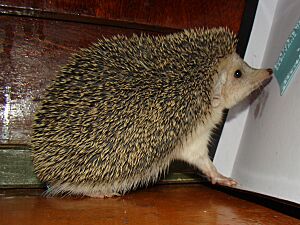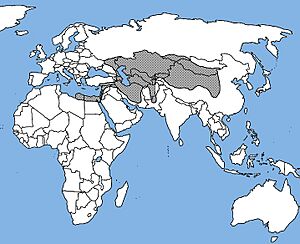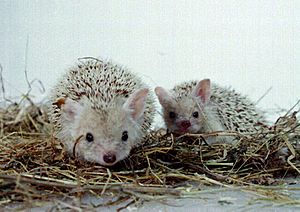Long-eared hedgehog facts for kids
Quick facts for kids Long-eared hedgehog |
|
|---|---|
 |
|
| Conservation status | |
| Scientific classification | |
| Genus: |
Hemiechinus
|
| Species: |
auritus
|
| Subspecies | |
|
H.a. auritus |
|
 |
|
| Geographic range of the long-eared hedgehog | |
The long-eared hedgehog (Hemiechinus auritus) is a small, spiky mammal. It lives in countries across Central Asia and parts of the Middle East. These hedgehogs are known for their long ears, which help them stay cool. They usually live in burrows, which are tunnels they dig or find.
Long-eared hedgehogs mainly eat insects. However, they can also eat small animals and plants. If kept as pets, they can live for more than seven years. It's important to buy them from a trusted seller. This is because wild hedgehogs can carry tiny bugs that might spread germs. For example, some wild hedgehogs have carried the brown dog tick, which can spread a fever called Boutonneuse fever.
Contents
About the Long-Eared Hedgehog
The long-eared hedgehog's head and body are about 12 to 27 centimeters (5 to 11 inches) long. Their tail is short, only about 1 to 5 centimeters (0.4 to 2 inches) long. Their ears are very long, about 3 to 4.5 centimeters (1.2 to 1.8 inches) longer than their closest spines. These long ears help them release heat in hot desert areas. They also have excellent hearing and a strong sense of smell. They use these senses to find food and avoid predators.
The hedgehog's spines are special. They are connected to a muscle that forms a pouch. This pouch helps protect the hedgehog. When danger is near, they can pull into this pouch and stick out their spines. Their spines are white at the tip with darker bands below. Unlike some other hedgehogs, they don't have dark and light areas on their faces. They also don't have a gap in their spines on the back of their necks. Their belly is light-colored, and the tips of their ears have whitish hairs. Their feet are hairy on top and on the heels, but the soles are bare.
The long-eared hedgehog is smaller than the West European hedgehog. It weighs between 250 and 400 grams (about 0.5 to 0.9 pounds). They are also much faster. When a predator comes close, they are less likely to curl into a ball. Instead, they often try to run away or jump at the predator using their short spines.
What Do Long-Eared Hedgehogs Eat?
Long-eared hedgehogs are insectivores, meaning they mostly eat insects. About 70% of their diet is made up of insects. They also eat some worms, and a small amount of slugs and snails. The idea that hedgehogs only eat slugs and snails is a myth. These foods make up only about 5% of their natural diet.
In the wild, their diet includes:
- 30% beetles
- 25% caterpillars
- 11% earthworms
- 10% bird eggs
- 5% mammal meat
- 5% slugs and snails
- 3% millipedes
- 3% earwigs
- 2% bees
- 1% bird meat
This specific hedgehog species, Hemiechinus auritus, looks for food in the early evening. They search for insects like grasshoppers and beetles. They also eat myriapods (like centipedes), gastropods (like snails), amphibians, small animals like lizards, eggs, fruits, and plants. They might even eat snakes or other small vertebrates. They protect themselves by curling up while eating struggling prey. They prefer to live near water. If water isn't available, they get their water from the food they eat.
Long-eared hedgehogs are active for most of the year. They hibernate for shorter periods, sometimes in summer or winter. The longest reported hibernation for this species is 40 days. These hedgehogs can travel up to 9 kilometers (about 5.6 miles) at night to find food.
Who Hunts Long-Eared Hedgehogs?
The Eurasian eagle owl is a common predator of the long-eared hedgehog. About 14% of this bird's diet is made up of these hedgehogs. They have also been hunted by the Pharaoh eagle owl in Jordan. Long-eared hedgehogs can also be hosts to tiny gut parasites, like Moniliformis cryptosaudi and Pachysentis ehrenbergi.
Where Do Long-Eared Hedgehogs Live?
The long-eared hedgehog lives in a wide area. This area stretches from the eastern Mediterranean region, through dry and grassy parts of Asia, to western Pakistan. It also extends from eastern Ukraine through Mongolia to China.
These hedgehogs are found in many countries, including:
- Afghanistan
- China
- Cyprus
- Egypt
- Iran
- Iraq
- Israel
- Kyrgyzstan
- Lebanon
- Libya
- Mongolia
- Pakistan
- Russia
- Syria
- Tajikistan
- Turkey
- Turkmenistan
- Ukraine
- Uzbekistan
Long-eared hedgehogs prefer places with mild climates. They avoid very hot deserts and cold northern mountains. They also like areas that get a moderate amount of rain, between 100 and 400 millimeters (4 to 16 inches).
They live in different types of dry grasslands, semi-deserts, and deserts. They like dry river valleys, ditches, and bushy areas. They often live near oases and human settlements, sometimes even in farm areas. They dig burrows under bushes, which can be about 45 centimeters (18 inches) long with one opening. They might also use burrows dug by other small animals. They are solitary animals and are active at night. During the day, they rest under rocks, in hollows, or in piles of rocks.
Life Cycle and Reproduction
Long-eared hedgehogs usually breed once a year, during the summer months from July to September. Their spines do not stop them from reproducing. The mother hedgehog carries her babies for 35 to 42 days. A female hedgehog has 8 to 10 nipples and usually gives birth to 2 or 3 babies at a time.
The babies are born with very few spines. Within five hours after birth, their spines double in size. After two weeks, the baby hedgehogs are fully covered with their new spines. They start eating solid food after just one week.
How Long-Eared Hedgehogs Help
Long-eared hedgehogs can be helpful to farmers. They eat harmful insects like termites and scorpions. They usually don't damage crops because they live in areas that are mostly empty land and desert.




